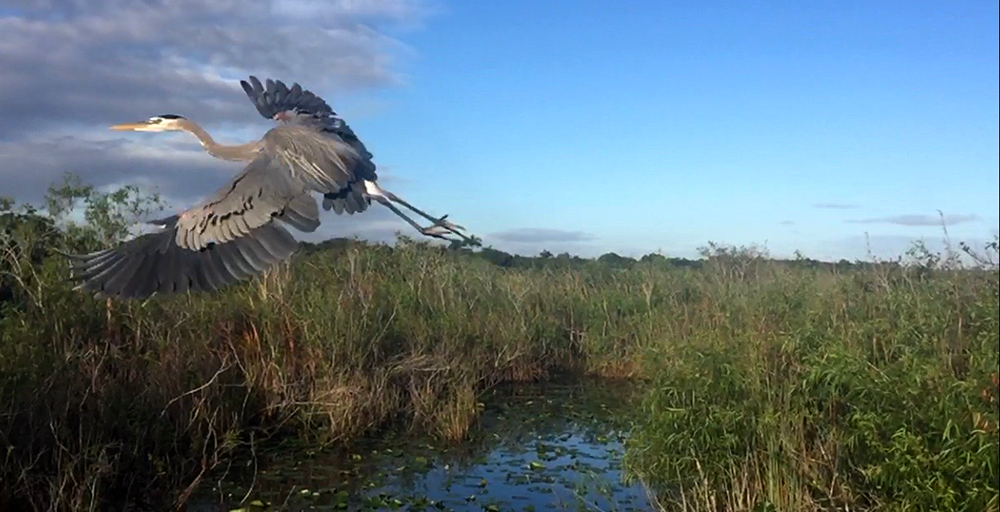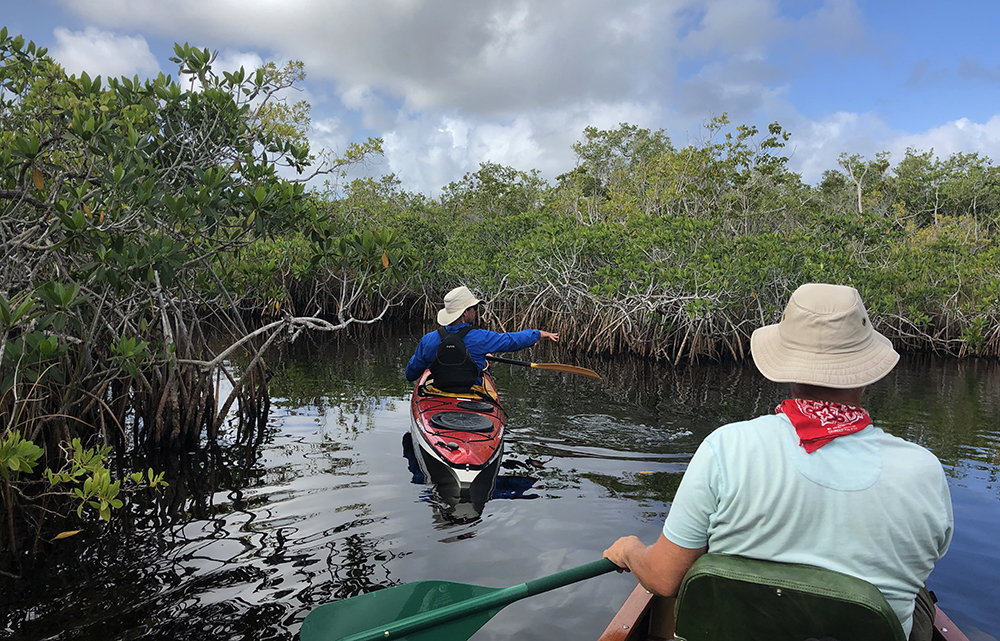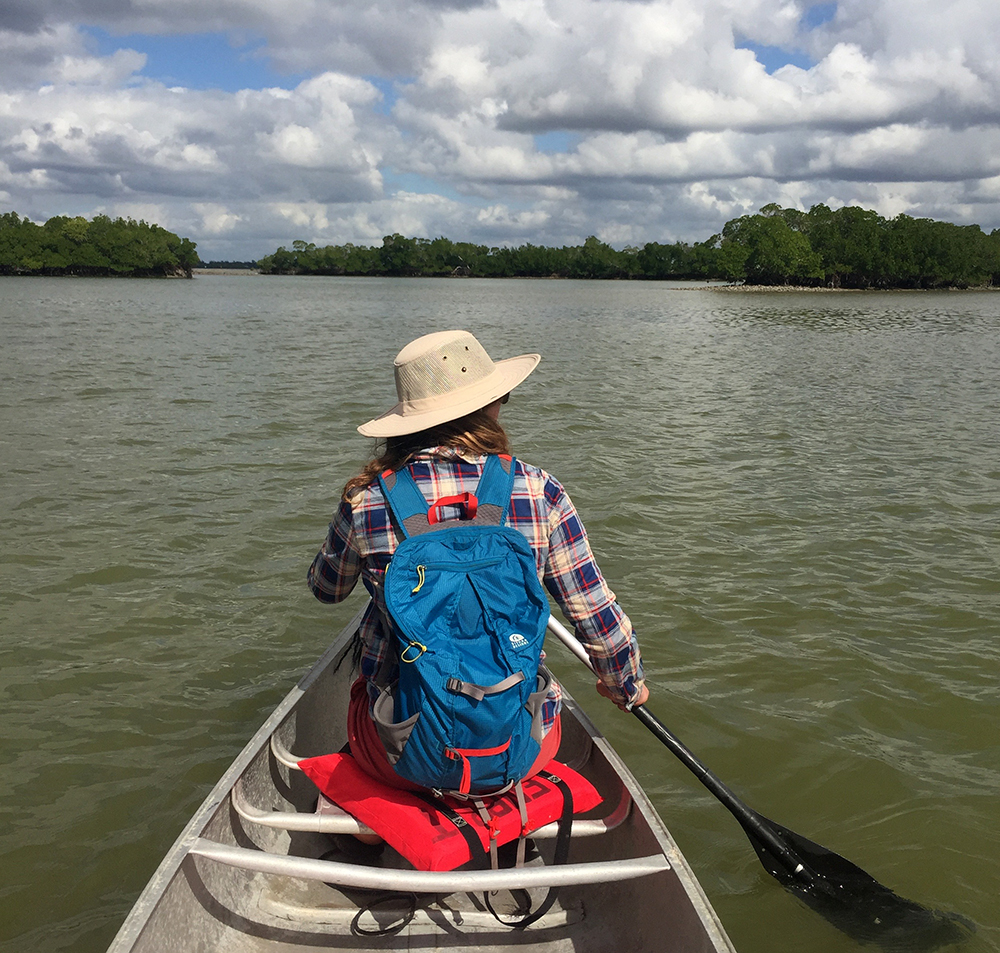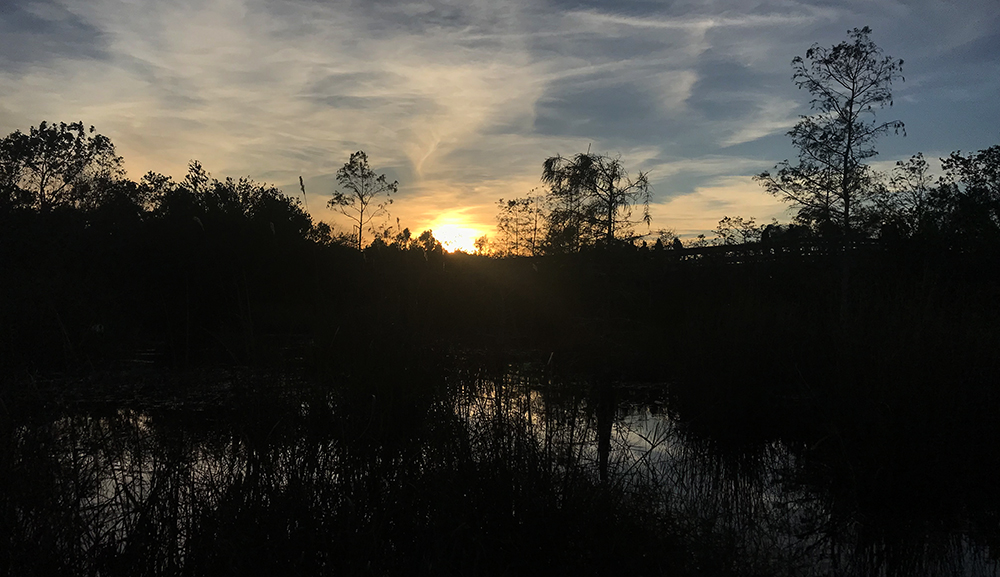Let’s be clear, there are no other Everglades… This place lives by its own rules. Endless miles of sawgrass, mangroves and dwarf cypress trees harbor an amazing array of wildlife here, in one of our most unique national parks.
Guide to Everglades
Everglades National Park
The Everglades are massive. Most visitors have no clue that this is the third largest National Park in the Lower 48, with more than 1.5 million acres, much of which is insanely difficult to access. While there are likely few, if any, areas of the park that have not seen human travel, whoever blazed the trail to these places was certainly a badass.
Everglades National Park beckons the ambitious to explore its forbidden waters and uncover truths about not only the land, but also about themselves…
Doubt it? Trust me, one battle with a swarm of vicious Everglades mosquitos, and you’ll learn something dark about yourself… very dark…
Home to more than 700 species of plants, some 360 species of birds, nearly 300 species of fish, more than 40 species of mammals and some 50 species of reptiles, Everglades National Park is a world away from nearby Miami, Florida.
These creatures enjoy the protection afforded by the third-largest national park in the lower 48, with more than 1.5 million acres of straight-up wilderness.

A River of Grass
Although it is commonly thought of as a swamp, the Everglades is actually a slow moving river. In reality, it is a River of Grass, as local author and icon Marjory Stoneman Douglas termed it in her 1947 book “The Everglades: River of Grass” which was released in the same year that the park was established.
Water flows at a snail’s pace from the northern waters of the Kissimmee River and Lake Okeechobee, accented by seasonal rains. While the park may seem large, it only protects a mere 1/5 of the original habitat its wildlife once enjoyed.

Large-scale urban development on both of south Florida’s coasts in addition to aggressive agricultural pursuits remove massive amounts of water from the seasonal flow that once provided sanctuary and sustenance for the park’s natural inhabitants. Consequently, many of the area’s endemic species are now found on the list of endangered species, or sadly, have simply left.
Nevertheless, the Everglades retains its majestic beauty and numerous activities offer visitors the opportunity to explore a land unlike any other in one of four distinct regions, each with its own visitor center.
Pinelands
The park’s southern entrance provides the only opportunity to actually drive through the Everglades. A 35-mile one-way drive leads to the village of Flamingo, passing through all of the park’s main ecosystems along the way. The first of these unique landscapes visitors will encounter on this route is the Pinelands.
The tall, thin slash pines of the Pinelands region stand tall against some of the most gorgeous sunsets you’ll ever see. These trees grow on areas of land that are elevated ever-so-slightly above the surrounding sawgrass prairies. An elevation change of mere inches can determine the type of vegetation present on any given piece of soil.
Some of the park’s more popular trails are found here, including the Pinelands Trail, along with the Gumbo Limbo and Anhinga Trails, which are found at Royal Palm. These short trails offer fabulous opportunities to observe the park’s wilder side and quickly usher casual explorers into the densely vegetated forests and watery grasslands of the Everglades.

The Lone Pine Campground provides a tranquil, yet scenic place to lay your weary head and the Earnest F. Coe Visitor Center is found 5-miles away, at the entrance to the park. Visitors can learn about and sign up for nearby ranger-led hikes and tours at the visitor center.
Don’t forget to accompany a ranger on a wet walk through the sawgrass, or a slog through the dwarf cypress forests. History junkies will enjoy a guided tour of the Nike Missile Range with provides an in-depth lesson on the anxiety of the 1960s Cold War.
This area also allows bicycles on a few of its more remote trails, and a quick pedal may prove an effective method of moving through such areas quickly, especially during the dreaded mosquito months of summer.
See the visiting page for more information.
Flamingo
This old fishing village turned remote outpost lies hidden among the mangrove forests near the southern tip of mainland Florida. Flamingo is a good basecamp for canoe or kayak trips into Florida Bay or the mangrove-lined brackish waters of the Everglades backcountry. Outings in this area generally provide views of wildlife and encounters with creatures not often found outside this unique ecosystem.

There used to be a resort in Flamingo, but a number of hurricanes in the early 21st century decimated the infrastructure of the lodge, restaurant and visitor center. Efforts began in 2017 to reintroduce visitor services here and are slated to continue during the 2020s.
The village now offers a visitor center, marina store and a food truck. Concessionaires once again provide guided boat tours on the Florida Bay and into the Whitewater Bay. Canoes, kayaks and houseboats are available for rent at the marina store and there is a glamping tent-camp at the Flamingo campground which is found at the end of the road.
See the visiting page for more information.
Shark Valley
Shark Valley gives guests an overview of the land from a 65-foot tall observation tower. A 15-mile roundtrip hike or bike ride along a paved trail leads past alligators, birds and turtles to the tower. From this elevated structure, it is immediately apparent how the name “Everglades” was applied to this unique landscape: the glades seem to go on forever.

For those who would rather be chauffeured to the tower, a tram tour is available and tikets can pe purchased at the Shark Valley Visitor Center. A couple of short nature trails are found near the visitor center. If you’re interested in an airboat ride, there are several businesses that offer rides just outside the park on Hwy 41, which is known as the Tamiami Trail.
This region of the park features the images that most imagine when the Everglades are brought to mind. Miles of sawgrass prairie unfolds before the eye, accentuated by small forests of hardwood trees that exist upon any ground that enjoys a few inches of elevation above its surroundings. These small forests are known as “hammocks”.
A few restaurants and shops are located along Hwy 41, but there are no lodging facilities in the area. Nevertheless, a stop at Shark Valley should really be considered mandatory, as the view from the tower explains the Glades in an instant.
See the visiting page for more information.
Gulf Coast
Adventurers who make it to the western Gulf Coast region have ample opportunity for epic canoe or kayak trips into the Ten-Thousand Islands. This area can provide a relaxing paddle that could last an afternoon, or more than a week.

More adventurous park junkies should note, this is the jumping-off point for the 99-mile Wilderness Waterway which weaves its way from the northwestern reaches of the Everglades, all the way to the water trail’s termination in Flamingo, on the southern edge of the contiguous 48 states.
There is a cool little scene here, with the town of Everglades City hosting the park’s Gulf Coast Visitor Center. The small community has some local flavor, and there are a number of hotels and restaurants that provide needed services. Canoes and kayaks can be rented near the visitor center and tickets for guided boat tours can be purchased here as well.
See the visiting page for more information.
Everglades in Peril
Sadly, this park is in danger, and efforts to save the Everglades are seeming to have at least some effect. It is largely unknown at this point however, if such measures will be enough to combat the toxic effects of the “progress” of civilization that continues nearly unabated in nearby urban centers.

Please visit the Everglades, and while you are there, ask how you can help the Glades. At least pick up some trash, there’s simply too much here…
This park and its residents need your help. It is a special land… I truly love this place…
See ya there..
Guide to Everglades
Relevant Links
National Park Guides

All content found on Park Junkie is meant solely for entertainment purposes and is the copyrighted property of Park Junkie Productions. Unauthorized reproduction is prohibited without the express written consent of Park Junkie Productions.
YOU CAN DIE. Activities pursued within National Park boundaries hold inherent dangers. You are solely responsible for your safety in the outdoors. Park Junkie accepts no responsibility for actions that result in inconveniences, injury or death.
This site is not affiliated with the National Park Service, or any particular park.
